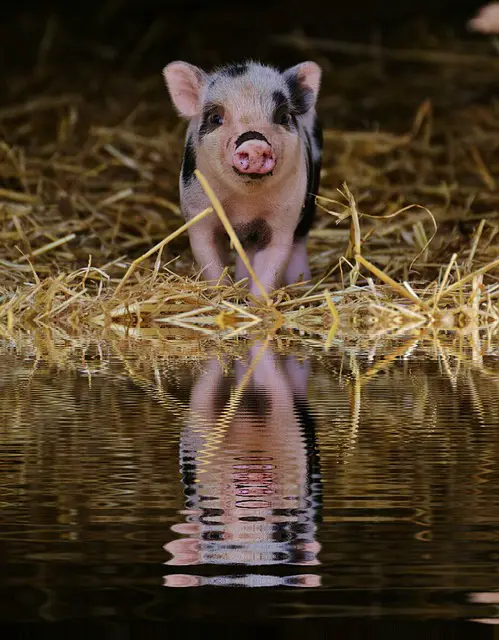Water is one of the most important parts of a pig’s diet and it’s important that your pig has enough water all the time.
How long can a pig go without water? A pig can go for up to 24 hours without water before it gets salt poisoning. Go beyond that, and you’re looking at the risk of death due to dehydration.
This is why it is important to give your pig easy access to water at all times, and not just after eating or playing. Especially during those hot summer months, the need to hydrate throughout the day also rises.

Why is Water Important to My Pig’s Health?
You may be wondering why there is such an emphasis on giving your pig as much water as you can even if you’ve been providing the right food and environment to keep it healthy.
Well, water actually has a number of uses for pigs:
- It helps maintain body temperature.
- It promotes the healthy function of cells.
- It helps deliver nutrients to the pig’s tissues.
- It helps in growth and reproduction.
- It helps remove waste from the pig’s body.
Especially if you have a young piglet in your hands, the role of water is even more critical. You see, a newborn piglet’s body weight is 80% from the water in its body, as opposed to a full-grown pig whose body weight is only 55% water.
How Much Water Does My Pig Need?
Your pig should be drinking 2.5 times more than its feed intake. This means that for every pound of feed that your pig eats, it should also be drinking 0.3 gallons of water. And that’s just for growing pigs!
Here’s the water intake that Dr. Marcia Carlson Shannon from the University of Missouri recommends for pigs based on the kind of pig you have:
Type of Pig
Nursery (0 to 60 lbs)
Grower (60 to 100 lbs)
Finisher (100 to 250 lbs)
Gestating pigs
Lactating pigs
Recommended Water Intake
0.7 to 1 gallon
2 to 3 gallons
3 to 5 gallons
3 to 6 gallons
5 to 7 gallons
These recommendations are based on the assumption that your pigs are in a comfortable environment and are at optimal health. Any changes in its health condition, housing situation, and even the weather or climate, may dramatically change your pig’s required amount of water.
When the recommended water intake for your pig is not followed, then your pig may become dehydrated.
Signs and Symptoms of Dehydration in Pigs
Salt poisoning is one of the initial threats you’ll face when your pig is dehydrated. But this doesn’t mean you’ll let your pig drink any kind of water just for the sake of it. Water and food that has high concentrations of salt may also lead to the same problem.
This is one good reason why you should be checking on your pig all the time. The signs of dehydration in pigs are usually easily noticeable based on their behavior. You just have to be observant enough to see them.
Here are the most common signs and symptoms of dehydration in pigs:
- Trying to drink water, but fails to do so
- Not eating, lack of appetite
- Constipation
- Evident nervousness and agitation
- Wandering about as if blind and deaf
- Uncoordinated movements
- Nose twitching
- Convulsions
These signs are usually seen in the first 24 to 48 hours, so be attentive. The longer your pig is dehydrated, and once salt poisoning kicks in, the chances of mortality becomes even higher. Rehydration must be done as soon as possible, but at the right pace.
What to Do In Case of Dehydration
It’s understandable for pig owners to panic when they realize that their pig is dehydrated, but try to clear your head and calm yourself down.
Just because you know that your pig needs rehydration doesn’t mean you’ll let it drink huge amounts of water right away. This could make things worse and could bring your pig much closer to death.
Reintroduce water to your pig gradually. This will allow their body to readjust accordingly without shocking their entire system with the fresh flow of water.
Ask your vet as well if you’re going to need to add electrolytes to your pig’s water. Although water naturally has some electrolyte content, this may not be enough.
Read this article to find out what role electrolytes play in your pig’s hydration.
If your pig is displaying some nervous ticks because of dehydration, it is best to place it in a dark, quiet corner so that it can calm down. Surround it with its preferred kind of bedding because the pig might end up injuring itself.
How to Prevent Dehydration and Salt Poisoning
As the cliche goes, prevention is always better than cure. Dehydration can be a highly traumatizing experience for your pig, so make sure you follow these tips to avoid dehydration:
- Regularly check the integrity of the water source.
Some pig owners wonder why their pigs aren’t drinking enough water when they have unlimited access to it, only to find out later on that there’s something wrong with the pipes or the water coming out of it.
Pigs may not be getting enough water to drink because of a breakdown in your pipeline. The water coming out of it may also be too hot or too cold for your pigs, which would still prevent them from drinking as much as they want.
Since you’re already (presumably) checking on your pig all the time, might as well check their water supply on each visit as well. You never know when these problems could happen. Don’t delay any maintenance work needed, as your pig’s life could be on the line when the problem gets worse.
- Avoid salty food.
Too much salt is already harmful to humans as it is. Just imagine how much damage it can do to a pig, whose biological system isn’t as complicated as ours.
A pig’s diet would normally contain around 0.4% to 0.5% salt. This is assuming that your pig is getting the recommended amount of water. When the pig’s water intake decreases and falls below the recommended amount, then this “normal” salt content in a pig’s diet easily becomes toxic. Think about that each time you’re adjusting your pig’s diet.
- Monitor your pig’s physical activity.
The more active your pig is, the more water it would also need. Especially when it comes to younger pigs, they often have faster metabolic rates than bigger and older pigs. This means that they easily lose the water they have in their body.
If your pig is super active, then make sure you supply it with more water as well so that it won’t get dehydrated as it plays or runs around.
- Vaccinate against illnesses that lead to dehydration.
Different illnesses and diseases can cause dehydration too, especially if vomiting is one of the symptoms that comes with it. Get all the needed vaccinations that would protect your pig against diseases that lead to dehydration.
Aside from ensuring that your pig gets the right vaccinations, maintain a clean and healthy environment as well. A clean environment minimizes the amount of potential health risks, because bacteria, viruses and parasites often thrive in dirt.
Be updated on potential health risks around your area, too. If you live in a hogging area, know that the risks are higher. Viruses and bacteria can be transported through dirt or contaminated water, so you need to have a few extra precautions in place. The presence of other wildlife may heighten the risks as well.
- Maintain the right temperature.
Remember that pigs do not have the same ability as humans to cool themselves off because of their lack of working sweat glands. This means that they are more susceptible to dehydration and heat stress when it gets too hot for them to handle.
The ideal body temperature of a piglet should be anywhere between 25°C and 32°C. As for growers and finishers, it should be anywhere between 16°C and 25°C.
Especially during the hot months, make sure you make the extra effort of cooling their bodies down. Encourage your pig to take mud baths or dips in your kiddie pool. Always monitor the temperature in its sleeping area as well.
Related Questions
How long can a pig live?
Pigs can live for up to 20 years, although this can only be achieved through good health and a great environment. This is a long way compared to pigs in the wild, whose life expectancy only averages 4 to 8 years. This is because they are exposed to a lot of threats out in the wild as compared to a pig kept as a pet.
How can I help my stressed pig?
You can start by giving your pet pig a blanket to snuggle into, then play some calming music. You should also be aware of what triggered the stress so that you can immediately remove them. Some pigs would also appreciate your company, especially if you’ve been around each other over a long period of time and your pig already trusts you.
